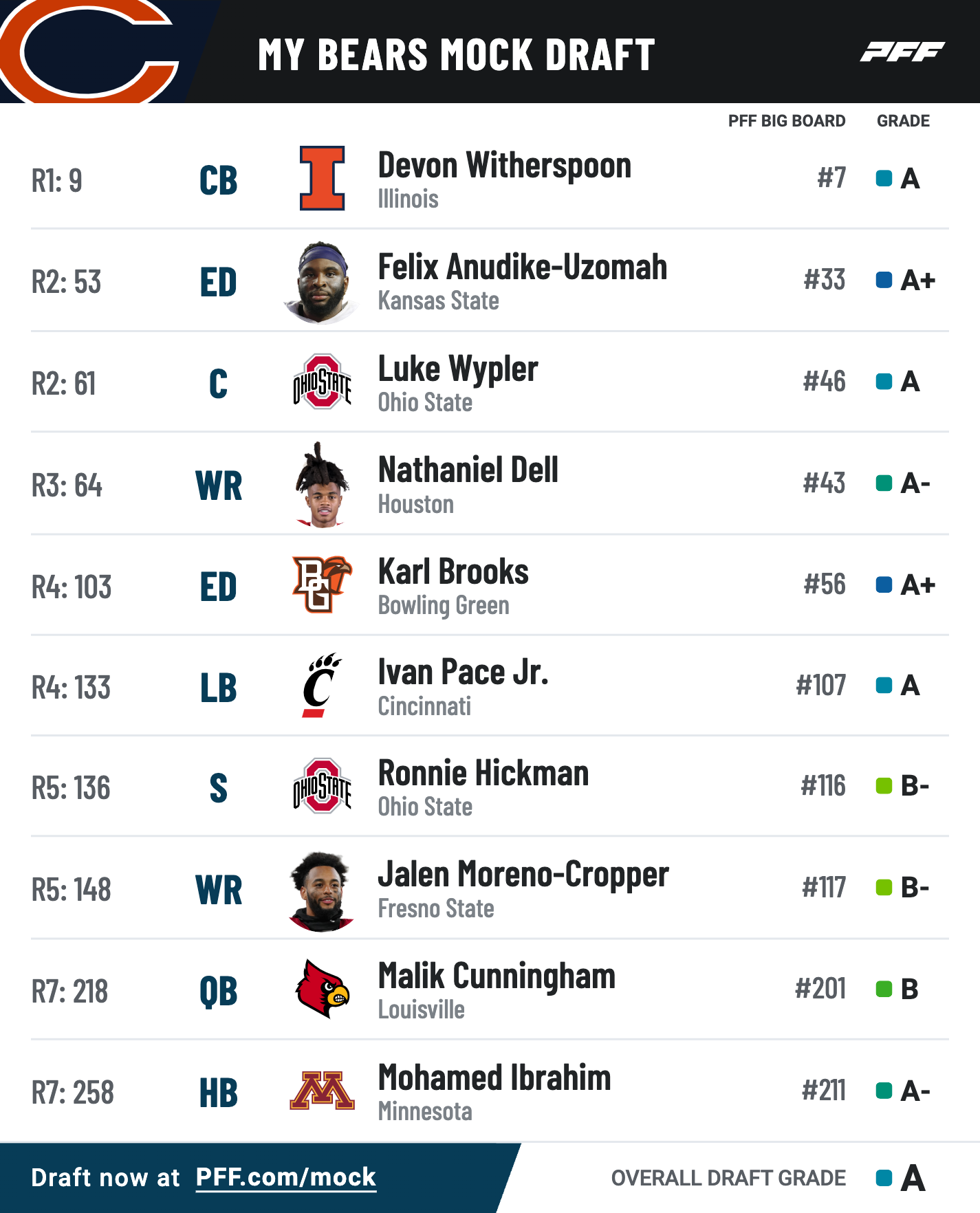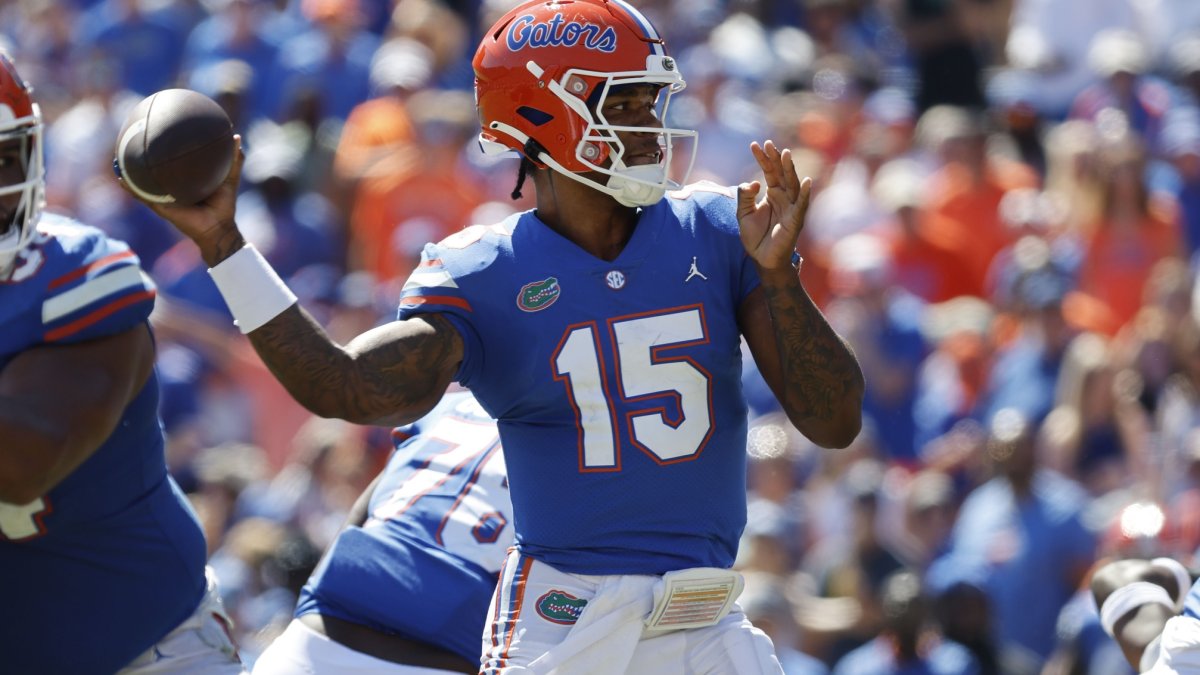• Bryce Young comes out on top: The Alabama quarterback recorded an absurdly low 2.0% turnover-worthy play rate in each of the last two seasons and throws with better anticipation than any prospect in recent memory.
• Anthony Richardson beats out C.J. Stroud: Richardson is the big swing in this draft. He is arguably the greatest athlete at the quarterback position ever to enter the draft, and he has a cannon of an arm and tape that shows that he can read defenses and work through progressions.
• Download the PFF draft guide today: Be sure to download the latest edition of the PFF draft guide, which is loaded with more than 300 pages of PFF-exclusive advanced stats, grades and analysis on some of the top prospects expected to enter the draft.
Estimated reading time: 6 minutes
Over on the PFF NFL Podcast, Steve Palazzolo and I have been busy running through our 2023 NFL Draft rankings at various positions. We've worked our way through quarterback, cornerback and wide receiver, and in the lead-up to the first round, we'll be presenting them in article form, too.
So here are my 2023 NFL Draft quarterback rankings. They are distinct from the official PFF big board ranking and based on my personal preference and interpretation of the data.
This is a fascinating class that includes four players who could all be drafted within the first 10 picks. However, the depth falls off fast, which could lead to a frenzy for that top four.
The Big 4
1. Bryce Young, Alabama
2. Will Levis, Kentucky
3. Anthony Richardson, Florida
4. C.J. Stroud, Ohio State
The conversation throughout the process has been about the top four quarterbacks. And I do think that this is a fair group to assemble, even if the wild differences between them likely result in teams and analysts reducing the top tier to a group of two or three.
In my eyes, there are things to like and dislike about each of them that I’m comfortable keeping them closely ranged, albeit in a specific order.
Young is the best prospect of the four, and the only thing that makes it close is the near-unprecedented extreme in terms of his size. At a fraction over 5-foot-10, he will be as short as any quarterback to play in anything recognizable as the modern game. And though he somehow got to 204 pounds at the NFL combine, a more realistic playing weight for him is closer to 190 pounds.
The Alabama quarterback recorded an absurdly low 2.0% turnover-worthy play rate in each of the last two seasons and throws with better anticipation than any prospect I can recall entering the draft. If he was 6-foot-2 and 220 pounds, the Panthers would have had the card with his name on it ready since they traded up to No.1.
Related: Bryce Young should be the No. 1 overall pick, regardless of his size
After Young, the question becomes, which risk are you most comfortable with? Is it Richardson’s historically poor accuracy, Stroud’s weak play under pressure outside of the Georgia game or Levis’ struggles in 2022?
I was encouraged enough with what Levis showed in 2021 when he ran an offense orchestrated by a legitimate NFL mind in former Rams offensive coordinator Liam Coen. His arm talent is obvious, but that season, Levis also posted a 90.6 PFF grade and made far more big plays with a better support structure around him.
As we approach the draft, Levis seems to be slipping more than any other passer in this top, but his 2021 tape is enough reason for me to buy in.
Related: Will Levis and the inexact science of QB evaluation
Richardson is the big swing in this draft. He is arguably the greatest athlete at the quarterback position ever to enter the draft, and he has a cannon of an arm and tape that shows that he can read defenses and work through progressions.
His problem is a prohibitively bad accuracy rate. Since 2017, the only quarterback with a comparable accuracy rate in terms of ball location is Trey Lance, with Richardson several percentage points worse than even Josh Allen.
If teams believe they can create the same kind of improvement in Richardson’s passing accuracy as the Bills saw in Allen’s, then there is a good argument that he should be the top pick of the draft. If they believe that’s a permanent part of his game, then his projection becomes a lot more difficult.
Related: The case for drafting QB Anthony Richardson No. 1 overall
Stroud is the quarterback from this group I am most worried about. His accuracy is stellar, but his play under pressure or in unideal circumstances has been bad during his entire college career. His PFF passing grade under pressure last season ranked in the 12th percentile among all quarterbacks — no legitimate quarterback prospect posted a lower mark.
Over two years, it climbs to the 34th percentile, which is still problematically bad. He showed against Georgia that he has that club in his bag, but that game is very much the outlier to his career. And that may place a cap on how good he can be.
Related: Biggest pro and con for PFF’s top quarterback prospects
High-End Backup
5. Clayton Tune, Houston
6. Stetson Bennett, Georgia
After the big four, this draft may already be out of players who have starting potential. Tune may be the next-best prospect in the draft and has a lot of data points that highlight his potential. His accuracy under pressure was among the best of any prospect, as was his overall accuracy in terms of ball location.
At 14.7%, Tune threw an uncatchable pass at the second-lowest rate in the draft. His 91.3 PFF passing grade was tied with Bryce Young in 2022.
Bennett is just a baller. He earned an 88.9 PFF passing grade in his final season at Georgia, averaging 9.1 yards per attempt. He’s athletic enough to run away from defensive backs and recorded just 12 turnover-worthy plays, three fewer than C.J. Stroud.
I wouldn’t want to bet against the idea that Bennett could overachieve in the NFL as well as college.
The X-Factor
7. Hendon Hooker, Tennessee
Hooker has legitimate NFL tools, and he also played exceptionally well in college. So, why is he ranked this low? The answer is that the Tennessee offense he ran is as far removed from an NFL system as you’re going to find outside of a triple option.
Hooker was almost exclusively limited to half-field reads that were either-or options for him, with one of the choices typically being wide open. We don’t know that Hooker can’t perform well in the NFL with vastly more complicated and difficult asks — and by all reports, he has been impressing teams in interviews and on the whiteboard — but you can’t assume that he is capable from his college tape, either. Throw in the fact that he’s already 25 and is coming off an ACL, and there are a lot of reasons to hesitate on Hooker.

Best of the Rest
8. Todd Centeio, James Madison
9. Tanner McKee, Stanford
10. Jake Haener, Fresno State
11. Aidan O’Connell, Purdue
12. Dorian Thompson-Robinson, UCLA
13. Jaren Hall, BYU
14. Malik Cunningham, Louisville
This is where the draft gets rough in a hurry. There are things to like about all of these quarterbacks, but none has a particularly good chance of being anything more than a career backup unless major changes happen. Todd Centeio is an intriguing name that doesn’t come up all too often in rankings. He played well for Colorado before lining up at quarterback for James Madison in 2022 and excelling. He threw for 9.4 yards per attempt this past year and recorded a career big-time throw rate of 5.0%.
O’Connell’s high-end plays are spectacular, but he makes inexplicably bad decisions with disturbing regularity, often looking like two completely different quarterbacks within the same game.
Thompson-Robinson is everybody’s favorite sleeper in this draft, but in his five-year college career he never got his PFF passing grade above 74.1 and had a higher turnover-worthy play rate than big-time throw rate — something that has almost no precedent of resulting in a good NFL player.
Sleeper
Tim DeMorat, Fordham
DeMorat led the nation in big-time throws in 2022 when combining the FBS and FCS. North Carolina's Drake Maye was second, eight plays behind the Fordham product. The 6-foot-4, 220-pound signal-caller averaged 9.7 yards per attempt and earned a 92.3 PFF passing grade. He flashed that potential during the All-Star circuit and has prototypical NFL size.




 © 2025 PFF - all rights reserved.
© 2025 PFF - all rights reserved.